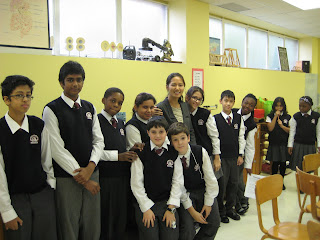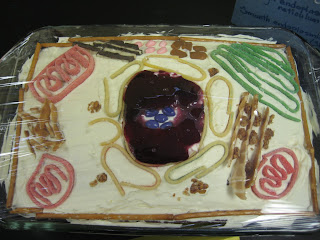Science
Science Presentation Due: December 5th (but you will be presenting in class in 6th)
on December 5th, I need your assignment sheet back for marking as well as other media/ posters
so I could get prepare for your presentation on following day.
Science Friday Quiz: This week's quiz will be based on whatever we learned so far (elements, mixture, solution, compounds, organic compounds and inorganic compounds).
6 Questions Total.
Math
If you still haven't correct your mistakes on Chapter 2 Test, Please do so.
Homework: Workbook P.39 Q. 1 and 2
Math Thursday Quiz: Will be on cartesian plane
Math making Games assignment Due: December 15th.
Please bring your stuff on Thursday. We will be working on making the games in class.
If you have questions, Please email me at
ekim039@gmail.com
Tuesday, 27 November 2012
Grade 10 Adventurers
Today, we saw an elephant toothpaste lab demo.
it was cool eh? :)
If you want, you could do a little version of the demo at home!
instead of using higher concentrated (30%) hydrogen peroxide and KI, you could get 3% hydrogen peroxide and yeast! :)
see below.
and we will be going over the chemical equation of the lab demo tommorrow!
2H2O2 → 2H2O + O2(g)
In this demonstration, yeast catalyzes the decomposition so that it proceeds much more rapidly than normal. The dishwashing detergent captures the oxygen that is released, making foam. Food coloring can color the film of the bubbles so that you get colored foam. In addition to being a nice example of a decomposition reaction and a catalyzed reaction, the elephant toothpaste demo is exothermic, so heat is produced
it was cool eh? :)
If you want, you could do a little version of the demo at home!
instead of using higher concentrated (30%) hydrogen peroxide and KI, you could get 3% hydrogen peroxide and yeast! :)
see below.
and we will be going over the chemical equation of the lab demo tommorrow!
- empty 20-oz plastic bottle (or other container)
- 3% hydrogen peroxide solution (available at nearly any store)
- packet of active yeast (from the grocery store)
- liquid dishwashing detergent (such as Dawn™)
- warm water
- food coloring (optional, but it looks nice)
- Pour 1/2 cup hydrogen peroxide solution, 1/4 cup dishwashing soap, and a few drops of food coloring into the bottle. Swish the bottle around to mix the ingredients. Set the bottle in a sink or outdoors or some other place where you won't mind getting wet foam everywhere.
- In a separate container, mix a packet of active yeast with a little warm water. Give the yeast about 5 minutes to activate before proceeding to the next step.
- When you are ready to do the demo, pour the yeast mixture into the bottle.
2H2O2 → 2H2O + O2(g)
In this demonstration, yeast catalyzes the decomposition so that it proceeds much more rapidly than normal. The dishwashing detergent captures the oxygen that is released, making foam. Food coloring can color the film of the bubbles so that you get colored foam. In addition to being a nice example of a decomposition reaction and a catalyzed reaction, the elephant toothpaste demo is exothermic, so heat is produced
Sunday, 25 November 2012
Grade 7 Edible Cell Presentation
Sorry My Grade 7s!
I am finally uploading some pictures from the presentation.
more pictures will be uploaded (from Mr.Wong's camera) sometimes nextweek! :)
Great Job Again!
I am looking forward to hear your presentation on December 5th!
I am finally uploading some pictures from the presentation.
more pictures will be uploaded (from Mr.Wong's camera) sometimes nextweek! :)
Mathew's Edible Cell
Zeid's edible cell
Sahat's Edible cell
Giri's Edible Cell
Zayd's Edible Cell
Razan's Edible Cell
Arta's Edible Cell
Warren's Edible Cell
KuuKua's Edible Cell
Great Job Again!
I am looking forward to hear your presentation on December 5th!
Wednesday, 14 November 2012
Grade 10/ 11 Science Chapter 4 Review
ST
Chapter
summaries
CHAPTER 4
Chapter
summaries
C
1
what are
changes in
matter?
• A
physical change alters neither the nature nor the characteristic
properties of matter. The atoms and molecules of the substance do not
change (p. 108).
• A
chemical change alters the nature and characteristic properties of
matter. The bonds between atoms are rearranged, and new molecules are
formed (p. 108).
• In
a nuclear transformation, the particles making up an atomic nucleus
are rearranged, and new elements are formed (p. 108).
2
CHEMICAL
CHANGES
• Chemical
changes
are
also
called
chemical
reactions
(p. 109).
• The
law of conservation of mass states that the total mass of reactants
is always equal to the total mass of products (p. 111).
• Balancing
a chemical equation consists in placing a coefficient before each
reactant and product so that the number of atoms of each element on
the reactant side is equal to the number of atoms of each element on
the product side (p. 111).
• Acid-base
neutralization is a chemical change involving the reaction of an acid
with a base, producing a salt and water (p. 119).
• Combustion
is a form of oxidation that releases a large amount of energy
(p. 122).
• Cellular
respiration is a chemical change in which glucose and oxygen are used
to generate energy. The reaction also produces carbon dioxide and
water (p. 123).
• Photosynthesis
is a chemical change that produces glucose and oxygen from solar
energy, carbon dioxide and water (p. 124).
Tuesday, 13 November 2012
Grade 7
Math
Chapter test 2 will be marked and given to students tommorrow, (wendesday)
No homework
Science
Homework: Read P.70-72
Science Quiz on Thursday this week.
Science assignment: Students have to choose their topic and partner (if they decide to work alone, that is fine as well) by Wendesday.
Science Presentation Assignment Due :November 30th.
Chapter test 2 will be marked and given to students tommorrow, (wendesday)
No homework
Science
Homework: Read P.70-72
Science Quiz on Thursday this week.
Science assignment: Students have to choose their topic and partner (if they decide to work alone, that is fine as well) by Wendesday.
Science Presentation Assignment Due :November 30th.
Grade 11
Support
activities – Concept review
MW4
P
answer
key
Concept
review: chemical
change,
conservation of matter,
decomposition and synthesis,
dissolution, oxidation,
photosynthesis and respiration,
physical change,
precipitation
hysical and chemical changes
conservation of matter,
decomposition and synthesis,
dissolution, oxidation,
photosynthesis and respiration,
physical change,
precipitation
1. Complete
the sentences,
using the
words in
the box
below. You
may not
need some
words, and
you may
use others
more than
once.
-
• always• atoms• chemical• chlorophyll• colour• combustion• element• energy• gas• matter• molecule(s)• nature• often• oxygen• solid• solute• solvent• substance(s)• sugars• water
nature
substance
nature
a) A
physical change
is a
transformation
that changes
neither the
________________________
nor the
characteristic
properties of
matter. No
new
________________________
is produced.
substances
colour
b) A
chemical change
is a
transformation
that changes
the
________________________
and
characteristic
properties of
matter. New
________________________
are produced.
The following
signs indicate
that a
chemical change
has occurred:
– There
is a
change in
________________________.
energy
– There
is a
change in
temperature.
gas
– A
large amount
of
________________________
is released
or absorbed.
solid
– A
________________________
is emitted.
– A
________________________
is formed
when two
liquids are
mixed together.
– The
change is
usually
irreversible.
matter
always
matter
c) According
to the
law of
conservation of
matter, in
all changes,
whether physical
or chemical,
the amount
of
_______________________
________________________
remains
the same.
The
mass of
________________________
does not
change.
solute
solvent
d) Dissolution
is the
process of
preparing a
solution by
mixing a
________________________
in
a
________________________.
chemical
oxygen
oxygen
e) Oxidation
is a
________________________
change involving
________________________
or a
substance with
properties
similar to
those of
________________________.
molecule
atoms
molecules
atoms
f) Synthesis
is the
formation of
a complex
____________________
from
____________________
or simpler
molecules.
Decomposition is
the
transformation of
complex
________________________
into simpler
molecules or
into
________________________.
sugars
water
chlorophyll
combustion
g) Photosynthesis
is the
process by
which producers
use solar
energy to
make their
food
(________________________)
from carbon
dioxide and
________________________.
This process
takes place
in cells
that contain
________________________.
Cellular
respiration is
the opposite
reaction to
photosynthesis.
It is
the process
by which
living cells
produce energy
through the
________________________
of complex
nutrients.
solid
h) Precipitation
is the
formation of
an insoluble,
or only
slightly soluble,
____________________
substance, called
a precipitate.
Precipitation may
occur when
two solutions
are combined.
2.
Are the
following
phenomena
physical or
chemical changes?
Check the
appropriate
column.
-
Physical changeChemical changea)A burning forest
b)Snow melting in the spring
c)The moulding of plastic
d)Photosynthesis in plants
3.
Various signs
indicate that
a chemical
change has
occurred or
is occurring.
What signs
could you
observe in
each of
the following
chemical changes?
Change
in colour and irreversible change
a) Rust
appears on
an object.
|
|
|
Formation
of a solid and irreversible change
b) When
you mix
vinegar with
milk, a
white solid
forms.
|
|
|
- WChange in temperature, release of a large amount of energy and emission of a gashen you recharge a car battery, an explosive gas (hydrogen) is formed, and the battery becomes hot.
|
|
|
4
. The
following are
steps you
might take
in lab
procedures. Check
the actions
that produce
a chemical
change.
-
a) You distill alcohol. b) You melt ice. c) You burn wooden splints. d) You mix a blue liquid with a yellow liquid, and the mixture turns green. e) You mix two liquids, and a precipitate forms. f) You mix two liquids, and the mixture gives off a large amount of heat.
Subscribe to:
Posts (Atom)

































